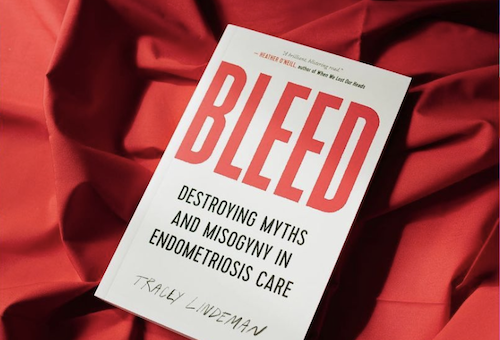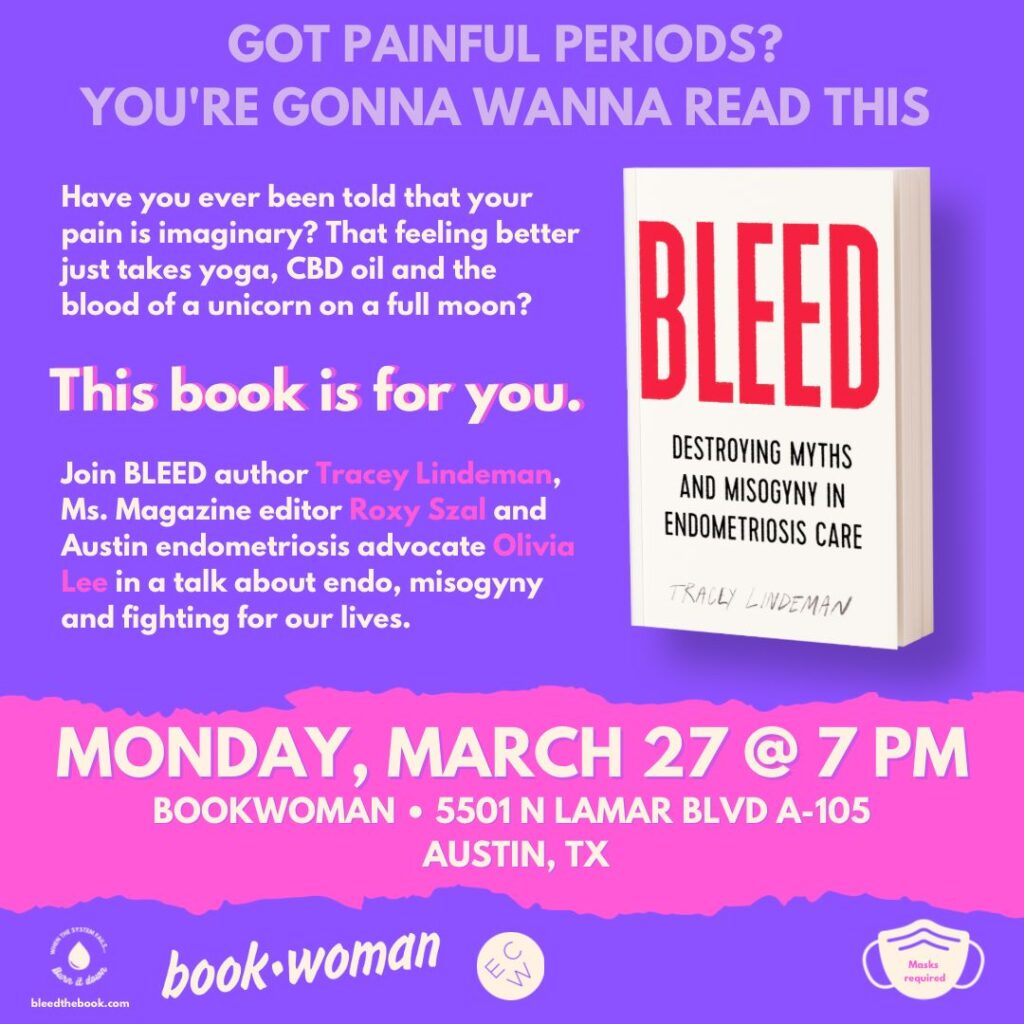The following is an excerpt from BLEED: Destroying Myths and Misogyny in Endometriosis Care by Tracey Lindeman.
Join Lindeman, Ms. editor Roxy Szal and advocate Olivia Lee in conversation about BLEED at BookWoman in Austin, Texas, on Monday March 27, at 7 p.m. CT. RSVP here.

Stephanie Lepage wonders how different her life could have been if only the doctors had bothered to look for endometriosis before her mid-30s.
Lepage had developed constant pain in her right lower abdomen that was so intense that rolling onto her side would shoot her out of a dead sleep on an almost nightly basis. When Lepage finally got in to see a gynecologist about it, that doctor said it was little more than a red herring. A cyst on the opposite side was merely referring pain—no connection, no pain meds, no problem. She remained in agony for two years without reprieve, living through 730 nights of interrupted sleep and 730 days of constant stabbing until it mysteriously subsided.
There were also times in her life when she avoided doctors completely. She didn’t see the point in subjecting herself to their judgment and experimentation, when not one single medical professional over the course of 20-odd years had been able to answer why her periods brought her such intense suffering.
Lepage, a cis white woman who is 38 when we speak, tells me that knowing what she knows now, it’s obvious she had all the classic symptoms of endometriosis. But by her early 30s, she still hadn’t been diagnosed. In place of a diagnosis, she had a collection of strange symptoms for which she took hormonal birth control for the better part of eighteen years. On the pill, sporadic pain and bleeding, a flatlining sex drive and painful dryness all chipped away at her enjoyment of life.
Not one single medical professional over the course of 20-odd years had been able to answer why her periods brought her such intense suffering.
In the Before Pill times, Lepage had long, heavy and painful periods.
In the After Pill times, her period did change: It became a bit shorter and much more intense. Even now, blood clots come so fast and furious she can sometimes feel them push her tampons out: “I will overflow my menstrual cup multiple times a day. I half-joke that my periods are solid now. They’re almost all blood clots because I’m bleeding so quickly.” She pauses, then laughs with a tinge of sadness. “Passing a blood clot the size of your palm through your cervix doesn’t feel good.”
And then another curveball came: She and her partner decided to try to have a baby.
***
When Lepage told her doctor she wanted to get pregnant, it was like a light switch got flipped. Her doctor warmly welcomed the news of Lepage’s intentions; in her mid-30s, she was getting a bit old.
As she soon found out, however, developing an embryo was far more difficult than she and her partner had anticipated. After six months, Lepage miscarried. She was deeply disappointed by that loss, but as a pragmatic person whose Ph.D. is in embryology and developmental biology, she knew exactly how normal it really was. She pushed it aside as much as she could and kept trucking along.
It was in a Chicago hotel room where she reached a major breaking point.
By then it had been a year since their conception efforts began. A little weekend getaway was more than merited, so she and her partner made the two-hour plane trip from Toronto to attend a friend’s wedding.
Unfortunately, her period joined them.
In the months since the miscarriage, she says her period had become “god-awful”—an excruciating, blood-soaked affair that made pants feel like a torture device. This one, though, was pure hell. There were stabbing cramps, painful bloating, diarrhea, massive clots—all the bells and whistles. At 4 a.m. the morning of the wedding, Lepage shook her partner awake. Drenched in a cold sweat, she begged him to go out and get her some drugs.
“I was contemplating trying to go to a doctor in Chicago. I thought I was going to have to walk into the emergency room,” she tells me.
The only reason she didn’t was the exorbitant cost of an ER visit at an American hospital. Instead, she holed up in the bathroom feeling like she was on the edge of death. The day of the wedding, she emerged from her porcelain prison for just one hour to show her face, as if she was giving the newly married couple the gift of a proof of life. What was meant to be a getaway had turned into a hostage situation, with Lepage’s uterus acting as her captor.
As soon as Lepage returned to Toronto, she booked an appointment with her doctor. Something needed to change. Her doctor had a long history of brushing her period problems aside, but surely she could not ignore the Chicago incident’s gravity—right?
Wrong. Lepage says her doctor looked completely uninterested as her patient complained of extreme pain and bleeding. Until, that is, Lepage dropped the bomb. “I’m also still unable to conceive,” Lepage told the doctor.
The GP snapped her head up, a gentle admonishment emanating from her lips: “Why didn’t you come to me sooner?” Her hands became a flurry of action as she ordered rounds of testing.
On her way home, Lepage thought about the encounter. “The thing that stood out to me the most was like, unless I was trying to conceive, no one even cared about bleeding and pain,” she tells me. “It’s like, ‘We don’t care about anything that has to do with your daily life and quality of life. It’s your job as a woman to procreate, and—oh my God, if you can’t procreate, then it’s a problem. Sure, we’ll take that seriously. But otherwise, eh, who cares?’”
She hated how easily the script was flipped, how those magic words—“I want a baby”— transformed her doctor.
In that moment, she became painfully aware of how the other side lives: how pregnancy and fertility care fast-track a patient through the system. It felt like a bizarro healthcare system where doctors actually help people with chronic illness. It was just so unfair, and yet here she was, benefiting from the same system that had kept a diagnosis and treatment away from her for so long. She clutched the life preserver thrown to her. Maybe now she would finally get some answers.
Excerpted and adapted from BLEED: Destroying Myths and Misogyny in Endometriosis Care by Tracey Lindeman © 2023 by Tracey Lindeman. All rights reserved. Published by ECW Press Ltd. www.ecwpress.com
RSVP to join Tracey Lindeman, Ms. editor Roxy Szal and advocate Olivia Lee in conversation about BLEED in Austin, Texas, on Monday March 27, at 7 p.m. CT.

Up next:
U.S. democracy is at a dangerous inflection point—from the demise of abortion rights, to a lack of pay equity and parental leave, to skyrocketing maternal mortality, and attacks on trans health. Left unchecked, these crises will lead to wider gaps in political participation and representation. For 50 years, Ms. has been forging feminist journalism—reporting, rebelling and truth-telling from the front-lines, championing the Equal Rights Amendment, and centering the stories of those most impacted. With all that’s at stake for equality, we are redoubling our commitment for the next 50 years. In turn, we need your help, Support Ms. today with a donation—any amount that is meaningful to you. For as little as $5 each month, you’ll receive the print magazine along with our e-newsletters, action alerts, and invitations to Ms. Studios events and podcasts. We are grateful for your loyalty and ferocity.





